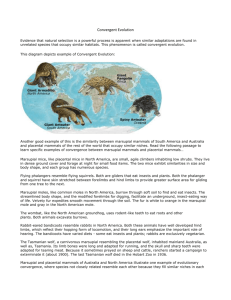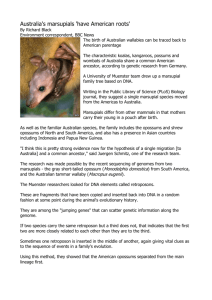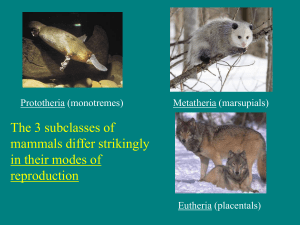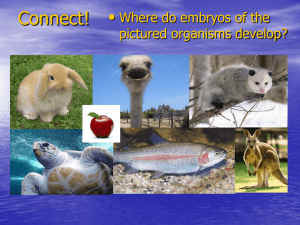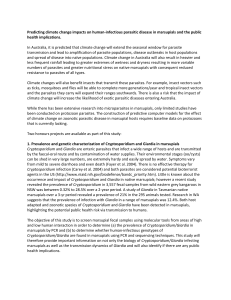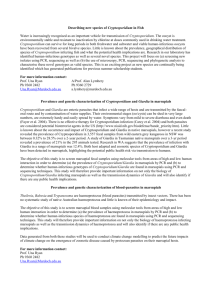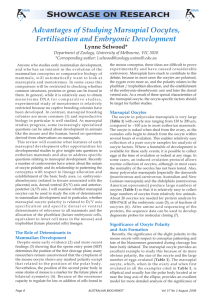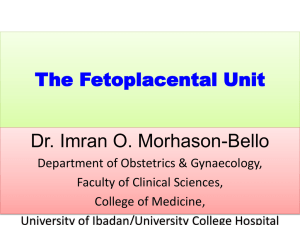ppt
advertisement
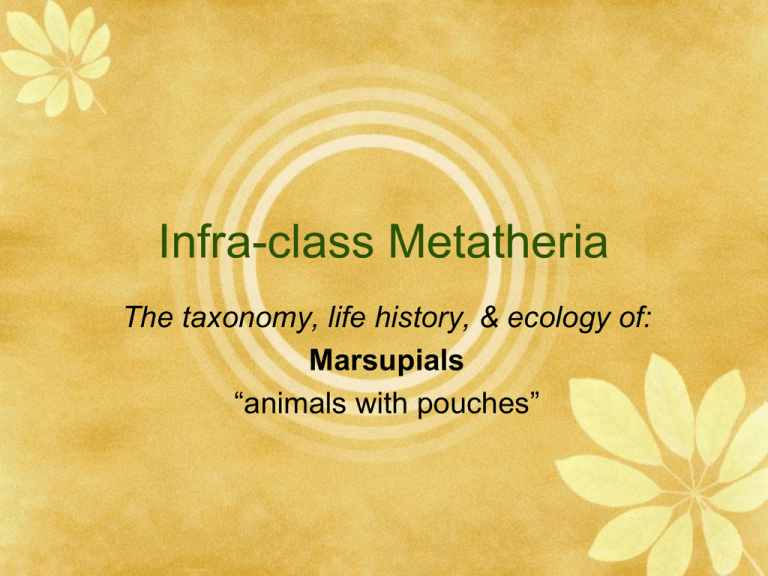
Infra-class Metatheria The taxonomy, life history, & ecology of: Marsupials “animals with pouches” Mammalia But first... Prototheria Theria Eutheria Metatheria Prototheria (4 species) = egg-laying monotremes Theria = live birth Metatheria (~280 species) = viviparous Eutheria (~4500 species) = placental birth Luo, Z. 2007. Transformation and diversification in early mammal evolution. Nature, 450, 1011-1019. 7 Orders (18 families): Didelphimorphia (American opossums) Paucituberculata ("shrew" opossums) Microbiotheria (monito del monte & extinct relatives) Dasyuromorphia (Australasian carnivorous marsupials) Peramelemorphia (bandicoots and bilbies) Notoryctemorphia (marsupial "moles") Diprotodontia (kangaroos, wallabies, possums, koalas, gliders, wombats, etc) *Two primary divisions within Marsupialia denote American marsupials and Australian marsupials. Adaptive Radiation largest smallest Fossil Evidence Suggests Marsupials Much More Common Marsupial origination is cited as Mongolia Advantages of placental development must have out-competed marsupial Australia has maintained diversity and dominance of marsupials because of isolation Distribution of Metatheria Virginia Opossum Only Marsupial in North America Very generalized Immune to rabies Can remain in involuntary comatose state for 1min. – 6 hrs. 13day gestation, when born size of honeybee More teeth than any other NA land mammal = 50 Convergent Evolution Filling the same ecological niche in diff. parts of the world. Seperated from common ancestor 100-150mya Marsupials still maintain diversity and dominance in Australia Flying Termite eating Foregut Fermentation Sugar glider arboreal marsupials. Flying squirrel, Arboreal placental Numbat (above) Anteater (right) Similar Habits Marupial (left) Antechinus stuartii Placental (right) Peromyscus maniculatus Burrowing Marsupial mole of Australia Placental: Golden mole of S. Africa Metatheria are different because… Development Ecretory/reproductive systems Cranial differences Epipubic bone Teeth Teeth Different number of incisors on top and bottom P3/3, M4/4 Delayed development of teeth The milk teeth are represented by a single premolar in each jaw Only replace one tooth postnatally Reproduction & Development Short gestation (8-43 days) Young born extremely small relative to adult size Organs not completely developed Well-developed front limbs for grasping fur Move to pouch or (if pouchless) grab ahold of teats Newborn Kangaroo 0.003% mother’s weight Major investment during Lactation Teat swells in its mouth to make a semi-permanent attachment Stays in pouch for 1 week - 1 year Leaves pouch at weight roughly equivalent to birthweight of a similarlysized placental Milk changes composition during lactation Early: high protein, low fat (for structural development) Later: low protein, high fat (for rapid increase in mass) Marsupial vs. Placental Character Diversity size structural adaptations Reproduction [Figs. 10.7] Placenta [Fig. 9.11] Lactation period [Fig. 10.7] Investment of energy in motherhood Cerebral Cortex/ Braincase Behavioural plasticity Territoriality Marsupial state 6% of living mammal species not as large less diverse brief gestation; semiembryonic young; body mass 1% of mother [Fig. 10.11]. Need for precocious grasping forelimbs may constrain adaptability choriovitelline (usually) Placental state 94% of living mammal species larger range of body sizes flying (wings), marine (fins) long short lower, altricial young higher, reproduce more rapidly (usually), precocial young long gestation period; young more developed at birth; body mass up to 50% of mother chorioallantoic Epipubic bones Baculum [Fig. 9.3] Auditory bullae smooth and complex, slow development, fast development, greater volume (maybe) smaller volume (maybe) uncommon great range of behaviours uncommon common and important highly developed, particularly in herding not well developed animals; capable of sustained high speeds present absent absent present in most derived from alisphenoid bone varies, but not alisphenoid primitive dental formula 5/4-1/1-3/3-4/4 Antipredator behaviour 3/3-1/1-4/4-3/3 TOP Avg. weight gain much greater in younger possums suggesting older mothers put put more effort into reproduction than maintenance/survival Middle Common bushtail possum Survival to breed the following year. Notice year 5 - ?? Bottom Mean Reproductive Effort measured as relative mass lost during lactation *Terminal Reproductive Hypothesis exemplified in Marsupials RE as loss of weight shows transfer of energy protrayed in yearling weight. Isaac, J.L. & Johnson, C.N. 2010. Terminal reproductive effort in a marsupial. Biology Letters. 1: 271275. Theoretical Constraints of Lactation Young have limited control over energy input - Marsupial mammary gland is relatively unresponsive to changes in suckling In placental animals, fetal hormones control more energy transfer Mother-offspring conflict constrains adaptive variation Sources http://www.biology.iastate.edu/InternationalTrips/1Australia/04papers/keuderDigSys.htm http://users.tamuk.edu/kfjab02/Biology/Mammalogy/systematics/A1metatheria.htm http://www.ucmp.berkeley.edu/mammal/marsupial/marsupial.html http://users.tamuk.edu/kfjab02/Biology/Mammalogy/systematics/A1metatheria.htm http://animaldiversity.ummz.umich.edu/site/accounts/information/Metatheria.html Google Images Tyndale-Biscoe, H. 2005. Life of Marsupials.
